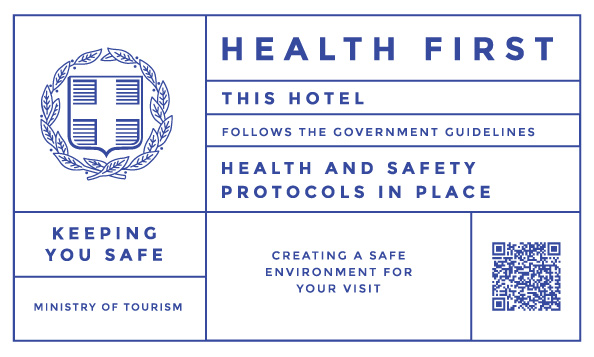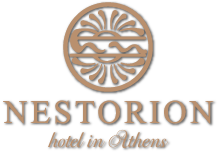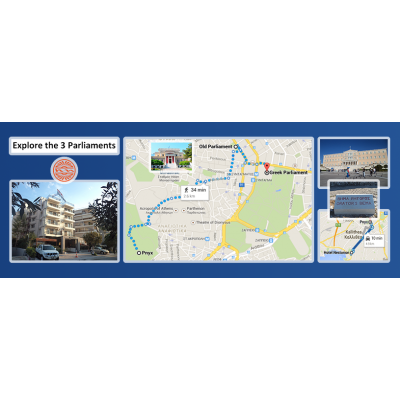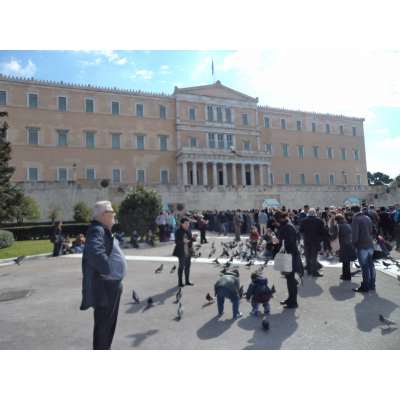3 Parliaments
the budget hotel in athens
Best to see the 3 Parliaments:
1. PNYX
http://www.stoa.org/athens/sites/pnyx.html
1. Property to stay: http://www.nestoriohotel.gr
2. Access Route: P.Faliro - Pnyx: https://goo.gl/maps/OzeZu
3. Walking Visit: 3 Houses: https://goo.gl/maps/KDSVo
4.. Leisure time: 2-3 hours
5. Return Path in hotel: https://goo.gl/maps/RyJ8c or Taxi to Pentelis 8 Palaio Faliro 6-8 euros
Pnyx is situated between the hill of the Muses (the location Philoppappus Monument) and the Hill of the Nymphs, (the location of the sanctuary of the Nymphs and the national Observatory). The semicircular square was after 6th century BC the location of the assembly of the people of Athens. They gathered here to hear orators to speak from a rock platform (bema) in the center of the Pnyx, and participate in the democratic assembly. The assembly is thought to have had a capacity of 10.000
2. OLD PARLIAMENT
http://www.athens24.com/the-old-parliament-house.html
http://www.nhmuseum.gr/facilities2.php?lang=1
Mansion of Old Parliament was founded in 1858 by Queen Amalia and built to plans by Francois Boulanger.
The Palace is directly connected with Greek history: it is the first permanent home of the Greek Parliament. With the expulsion of King Otto and the restoration of 1862 repealed the body of the Senate. The building plans are modified by Greek architect Panagiotis Kalkos main change with the abolition of the amphitheater of the Senate. The Parliament building is completed in 1875.
On August 11 performed the official opening of the sittings of the Parliament by Prime Minister Charilaos Trikoupis. For 60 years the building on Stadiou Street houses the turbulent political life of the country. In 1935 the Greek Parliament relocates the Old Palace in Syntagma Square. The building of the Old House now granted by decision of the Prime Minister Eleftherios Venizelos in the Historical and Ethnological Society of Greece in order to house the National History Museum. The fact later confirmed by decree but delayed to implement because of the war and the events that followed.
Today, the Old House is an architectural jewel in the center of Athens. The grand hall of the Conference is historical memory and adequate housing for important historical and cultural events. The halls that surround it house the permanent exhibition of the National Historical Museum and the gallery is the temporary exhibitions space.
3. THE GREEK PARLIAMENT
http://foundation.parliament.gr/central.aspx?sId=106I344I938I323I434741
Dominating Syntagma Square, the building was the residence of the first king of Greece Otto. The building was constructed from 1836 to 1842, George A’, who succeeded Otto on the throne, also resided in the palace. During his reign, two successive fires destroyed the building, making it unsuitable for use as a royal residence. In 1924 the government decided to situate Parliament in the building. Reconstruction work was completed in 1934. The interior was redesigned by architect A.Kriezis. In Parliament you will find national treasures, such as the first Greek Constitution, a collection of valuable paintings and a large library.
1. PNYX
http://www.stoa.org/athens/sites/pnyx.html
1. Property to stay: http://www.nestoriohotel.gr
2. Access Route: P.Faliro - Pnyx: https://goo.gl/maps/OzeZu
3. Walking Visit: 3 Houses: https://goo.gl/maps/KDSVo
4.. Leisure time: 2-3 hours
5. Return Path in hotel: https://goo.gl/maps/RyJ8c or Taxi to Pentelis 8 Palaio Faliro 6-8 euros
Pnyx is situated between the hill of the Muses (the location Philoppappus Monument) and the Hill of the Nymphs, (the location of the sanctuary of the Nymphs and the national Observatory). The semicircular square was after 6th century BC the location of the assembly of the people of Athens. They gathered here to hear orators to speak from a rock platform (bema) in the center of the Pnyx, and participate in the democratic assembly. The assembly is thought to have had a capacity of 10.000
2. OLD PARLIAMENT
http://www.athens24.com/the-old-parliament-house.html
http://www.nhmuseum.gr/facilities2.php?lang=1
Mansion of Old Parliament was founded in 1858 by Queen Amalia and built to plans by Francois Boulanger.
The Palace is directly connected with Greek history: it is the first permanent home of the Greek Parliament. With the expulsion of King Otto and the restoration of 1862 repealed the body of the Senate. The building plans are modified by Greek architect Panagiotis Kalkos main change with the abolition of the amphitheater of the Senate. The Parliament building is completed in 1875.
On August 11 performed the official opening of the sittings of the Parliament by Prime Minister Charilaos Trikoupis. For 60 years the building on Stadiou Street houses the turbulent political life of the country. In 1935 the Greek Parliament relocates the Old Palace in Syntagma Square. The building of the Old House now granted by decision of the Prime Minister Eleftherios Venizelos in the Historical and Ethnological Society of Greece in order to house the National History Museum. The fact later confirmed by decree but delayed to implement because of the war and the events that followed.
Today, the Old House is an architectural jewel in the center of Athens. The grand hall of the Conference is historical memory and adequate housing for important historical and cultural events. The halls that surround it house the permanent exhibition of the National Historical Museum and the gallery is the temporary exhibitions space.
3. THE GREEK PARLIAMENT
http://foundation.parliament.gr/central.aspx?sId=106I344I938I323I434741
Dominating Syntagma Square, the building was the residence of the first king of Greece Otto. The building was constructed from 1836 to 1842, George A’, who succeeded Otto on the throne, also resided in the palace. During his reign, two successive fires destroyed the building, making it unsuitable for use as a royal residence. In 1924 the government decided to situate Parliament in the building. Reconstruction work was completed in 1934. The interior was redesigned by architect A.Kriezis. In Parliament you will find national treasures, such as the first Greek Constitution, a collection of valuable paintings and a large library.




